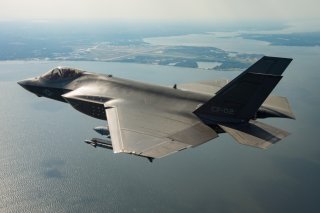Stormbreaker: How the F-35 Can Destroy Targets in Any Scenario
The weapon, which is now ready for war, is planned for the F/A-18 and F-35 and, in a recent development, it is now operational on an Air Force F-15E.
Here's What You Need to Remember: “Weapons will have the capability to exchange information between themselves and the nodes linked to the network. The result will be a weapon that collaboratively interfaces with the network, adjusts its trajectory in-flight to enhance accuracy, and provides real-time impact assessment,” the essay states.
Perhaps enemy ground vehicles moving toward an attack have been engineered with certain kinds of infrared suppressors to lower heat emissions and therefore be less detectable to thermal infrared targeting? Similarly, perhaps an enemy vehicle has turned its engines off while remaining stationary in a forward attack position, for the purpose of lowering heat and noise signatures? In this kind of scenario, laser-guided targeting might be the preferred method of engagement. A ground or air generated laser designator could “paint” or illuminate such a tricky target for the Stormbreaker bomb.
Preparing for these kinds of varied attack dynamics in air war forms the basis for why the Air Force and Raytheon have engineered the Stormbreaker weapon, a multi-mode air-dropped weapon designed to destroy targets with millimeter wave, infrared or semi-active laser technology.
The weapon, which is now ready for war, is planned for the F/A-18 and F-35 and, in a recent development, it is now operational on an Air Force F-15E. The Stormbreaker was engineered with the strategic recognition the future targets in major war will be much more difficult to reach given enemy countermeasures, sensor detection ranges and an increase in stand-off weaponry. With this in mind, Air Force and Raytheon developers sought to engineer a multi-mode targeting link able to draw upon a two-way data link to track and destroy enemy targets from distances as far at forty miles.
Arming the F-15E is a first step for the Air Force as it continues Stormbreaker development. With the F-35, the weapon will be able to operate from an internal weapons bay so that the aircraft can maintain its stealth properties.
The advantages of laser and infrared-targeting for the Stormbreaker are explained in a June 2020 Congressional Research Service report called “Precision Guided Munitions.” “The added laser guidance enables the Stormbreaker to strike both fixed and moving targets. Stormbreaker uses Link 16 and ultra-high frequency datalinks, along with infrared guidance, to provide course corrections,” the report states.
The Stormbreaker’s two-way data link aligns with concepts expressed in an interesting essay called “Precision-Guided Munitions of the Future” by a North Atlantic Treaty Organization-aligned think tank called the Joint Air Power Competence Centre. A portion of the essay takes up the evolution of Network Enabled Warfare as a basis upon which to analyze the trajectory of precision weaponry development. As networks become increasingly hardened and expanded, weapons will increasingly operate with an ability to rapidly re-task as needed amid fast-changing war circumstances.
“Weapons will have the capability to exchange information between themselves and the nodes linked to the network. The result will be a weapon that collaboratively interfaces with the network, adjusts its trajectory in-flight to enhance accuracy, and provides real-time impact assessment,” the essay states.
Raytheon weapons developers, one could observe, seem to have anticipated this technical trend years ago when first embarking upon Stormbreaker development.
Kris Osborn is the new Defense Editor for the National Interest. Osborn previously served at the Pentagon as a Highly Qualified Expert with the Office of the Assistant Secretary of the Army—Acquisition, Logistics & Technology. Osborn has also worked as an anchor and on-air military specialist at national TV networks. He has appeared as a guest military expert on Fox News, MSNBC, The Military Channel, and The History Channel. He also has a Masters Degree in Comparative Literature from Columbia University. This article first appeared last year and is being republished due to reader interest.
Image: Reuters

